
The Perfect Turkey Roll Oven Recipe: A Comprehensive Guide
Are you looking for a delicious and impressive dish to serve at your next gathering or special occasion? Look no further than the exquisite turkey roll oven recipe! This mouthwatering dish combines the succulent flavors of turkey and a variety of delectable ingredients, resulting in a delightful culinary experience. In this comprehensive guide, we will delve into the food science, culinary details, selection, cleaning, preparation, tips, variations, and doneness checks, ensuring that you have all the information needed to master this dish. So let’s get started!
Food Science and Culinary Details
Understanding the science behind cooking is key to achieving the perfect turkey roll. The turkey breast, being a lean and mild-tasting meat, requires special attention to ensure it remains moist and flavorful. The combination of brining and rolling helps to retain moisture and tenderize the meat, enhance flavors, and create a beautifully presented dish.
Selecting the Right Turkey Breast
When it comes to choosing the perfect turkey breast for your roll, there are a few factors to consider. Look for a boneless, skin-on turkey breast that weighs around 2.5-3 pounds. This size is ideal for rolling and ensures the meat cooks evenly. Additionally, opt for a high-quality turkey breast from a reputable source to guarantee great flavor and texture.
Cleaning and Preparing the Turkey Breast

Before preparing the turkey breast, it is crucial to thoroughly clean it. Start by rinsing the breast under cold water to remove any excess brine or impurities. Pat the turkey breast dry with paper towels, ensuring the skin is completely dry. Moisture on the skin can hinder achieving a crispy exterior.
Brining for Flavor and Moisture

Brining is an essential step in this recipe as it imparts incredible flavor and helps lock in moisture. To prepare the brine, dissolve 1 cup of salt, 1/2 cup of sugar, and aromatic spices of your choice, such as rosemary or thyme, in 2 quarts of cold water. Submerge the turkey breast in the brine, ensuring it is fully covered. Let it brine in the refrigerator for 4-6 hours or overnight for maximum flavor infusion.
Preparing the Filling

While the turkey breast is brining, you can start preparing the delicious filling for your roll. The possibilities are endless when it comes to filling variations. A popular choice is a combination of sautéed vegetables, such as onions, mushrooms, and bell peppers, seasoned with herbs and spices.
Sauté the vegetables in olive oil until they become tender and fragrant. Once cooked, transfer to a bowl and allow them to cool completely. At this point, you can also add other ingredients to elevate the flavors, like cooked bacon, grated cheese, or nuts.
Assembling and Rolling the Turkey Breast

Once your turkey breast has finished brining, remove it from the brine, rinse it thoroughly under cold water, and pat it dry again. Place the breast on a clean surface, skin side down, and spread the prepared filling evenly over the surface, leaving a small border to prevent spillage during rolling.
Starting from one of the shorter edges, tightly roll the turkey breast like a jelly roll or Swiss roll. Secure the roll with kitchen twine, tying it at even intervals along the length of the turkey to maintain its shape during cooking.
Cooking Tips for Turkey Roll
To ensure your turkey roll is cooked to perfection, consider the following tips:
-
Preheat the Oven: Start by preheating your oven to 350°F (175°C). A properly heated oven provides an even and consistent cooking environment.
-
Basting: Basting the turkey roll throughout the cooking process adds moisture and enhances flavors. Brush the roll with melted butter or olive oil every 30 minutes to keep it succulent.
-
Meat Thermometer: Using a reliable meat thermometer is crucial to achieving the desired level of doneness. Insert the thermometer into the thickest part of the turkey roll, ensuring it does not touch the filling or the roll’s surface. The internal temperature should reach 165°F (74°C) for safe consumption.
-
Resting Period: Allow the cooked turkey roll to rest for 10-15 minutes before carving. This allows the juices to redistribute, resulting in juicier slices.
Recipe: Turkey Roll Oven Recipe
Let’s take a detailed look at the step-by-step recipe for preparing the turkey roll:
Ingredients:
-
1 boneless, skin-on turkey breast (2.5-3 pounds)
-
For the brine:
-
1 cup salt
-
1/2 cup sugar
-
2 quarts cold water
-
Aromatic spices (rosemary, thyme, etc.)
-
-
For the filling:
-
Sautéed vegetables (onions, mushrooms, bell peppers, etc.)
-
Seasonings (herbs, spices, etc.)
-
Optional additional ingredients (bacon, grated cheese, nuts, etc.)
-
Instructions:
-
Prepare the brine by dissolving salt, sugar, and aromatic spices in cold water.
-
Submerge the turkey breast in the brine and refrigerate for 4-6 hours or overnight.
-
While the turkey is brining, prepare the filling by sautéing vegetables, seasoning, and adding any optional ingredients.
-
Remove the turkey breast from the brine, rinse under cold water, and pat dry.
-
Spread the prepared filling evenly over the turkey breast, leaving a small border.
-
Roll the turkey breast tightly, securing it with kitchen twine at even intervals.
-
Preheat the oven to 350°F (175°C).
-
Place the rolled turkey on a rack in a roasting pan.
-
Baste with melted butter or olive oil every 30 minutes during cooking.
-
Use a meat thermometer to check for doneness, ensuring an internal temperature of 165°F (74°C).
-
Once cooked, allow the turkey roll to rest for 10-15 minutes before carving.
-
Carve into beautiful slices and serve with your favorite side dishes.
Conclusion
Congratulations! You are now equipped with the knowledge and understanding needed to create a stunning turkey roll using your oven. The food science, culinary details, selection, cleaning, preparation, tips, and variations covered in this comprehensive guide will ensure success every time you prepare this delicious dish. Adapt the filling to your taste, experiment with different seasonings, and enjoy the process of creating a masterpiece that will impress your guests and leave them craving more. So roll up your sleeves and get ready to indulge in an extraordinary culinary adventure with the turkey roll oven recipe!
Sources
FAQS On Turkey Roll Oven Recipe
What Ingredients Are Needed To Make A Turkey Roll?
For a basic turkey roll recipe, you will need a boneless turkey breast, herbs and spices of your choice, olive oil, and butter. You can also add other ingredients such as bacon, cheese, or vegetables for more flavor.
How Long Does It Take To Cook A Turkey Roll In The Oven?
The cooking time for a turkey roll will vary depending on the size of the roll. As a general rule, it takes about 20 minutes per pound to cook a turkey breast in the oven. So, a 3-pound turkey roll would take approximately 60 minutes to cook.
Should The Turkey Roll Be Covered While Cooking In The Oven?
Yes, it is best to cover the turkey roll with aluminum foil while cooking in the oven. This helps to keep the moisture in and prevent the meat from drying out.
How Can I Check If The Turkey Roll Is Done Cooking?
The best way to check if the turkey roll is done is by using a meat thermometer. The internal temperature should reach 165°F (74°C) to ensure that it is fully cooked. If you don’t have a thermometer, you can also make a small cut in the thickest part of the roll to check if the meat is white and no longer pink.
Can I Make A Turkey Roll Ahead Of Time And Reheat It In The Oven?
Yes, you can make a turkey roll ahead of time and reheat it in the oven. Simply cover the roll with foil and refrigerate it. When ready to serve, reheat the roll in a preheated oven at 375°F (190°C) for 20-30 minutes, until heated through. It is important to ensure that the internal temperature reaches 165°F (74°C).


